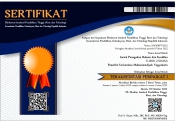Pertanggungjawaban Hukum Proksi atas Kejahatan Internasional Melalui “Taylor’s Doctrine”
DOI:
https://doi.org/10.18196/jphk.v2i1.10401Keywords:
Perang Proksi, Pertanggungjawaban Hukum, Doktrin TaylorAbstract
Perkembangan teknologi dan hubungan internasional telah memaksa perubahan fundamental dalam perang atau konflik, dimana perang konvensional dianggap tidak relevan lagi digunakan ketika terjadi konflik antara para pihak yang terlibat (belligerent). Kondisi tersebut menjadikan konsep perang proksi yang dikenal juga sebagai konsep berperang secara tidak langsung (indirect involvemen) menjadi salah satu mekanisme berperang yang paling populer saat ini. Namun, pergeseran teknis-mekanis tersebut tidak menghilangkan fakta bahwa perang merupakan salah satu faktor utama pendorong terjadinya kejahatan internasional yang menjadi ancaman bagi nilai-nilai kemanusiaan universal. Bentuk perang proksi yang tidak langsung, tersembunyi dan cenderung tidak tampak menjadi tantangan bagi penegakan hukum internasional, khususnya dalam memetakan pertanggungjawaban kejahatan internasional yang dilakukan oleh proksi maupun pihak yang melakukan proxy intervention. Dengan menggunakan metode penelitian hukum normatif, penelitian ini melakukan analisis terhadap regulasi, konsep dan doktrin dalam hukum internasional, dalam hal ini “Taylor’s Doctrine” yang menyediakan konsep “aiding and abetting” untuk melihat relasi antara proksi dengan proxy intervention dalam kaitannya dengan pertanggungjawaban atas kejahatan internasional yang telah terjadi.
References
Ambos, Kai dan Ousman Njikam. (2013). Charles Taylor’s Criminal Responsibility. Journal of International Criminal Justice, 11(4). https://doi.org/10.1093/jicj/mqt042
Deutsch, Karl. (1964). External Involvement in Internal Wars, dalam Harry Eckstein, Internal War: Problems and Approaches. New York: Free Press of Glencoe.
Gilder, Alexander. (2017). Bringing Occupation Into The 21st Century: The Effective Implementation of Occupation By Proxy. Utrecht Law Review, 13(1). https://doi.org/10.18352/ulr.355
Hughes, Geraint. (2014). My Enemy's Enemy: Proxy Warfare in International Politics. Brighton:, Sussex Academic Press.
Innes, Michael A. (2012). Making Sense of Proxy Wars: States, Surrogates & the Use of Force. Washington D.C: Potomac Book.
Keeley, Lawrence. (1996). War Before Civilization: The Myth of the Peaceful Savage. Oxford: Oxford University Press.
Liber, Depri Sonata. (2014). Metode Penelitian Hukum Normatif dan Empiris: Karakteristik Khas dari Metode Meneliti Hukum. Fiat Justitia Jurnal Ilmu Hukum, 8(1). https://doi.org/10.25041/fiatjustisia.v8no1.283
Loveman, Chris. (2002). Assessing the Phenomenon of Proxy Intervention, Conflict. Security & Development, 2(3). https://doi.org/10.1080/14678800200590618
Mumford, Andrew. (2013). Proxy Warfare. Cambridge: Polity Press. Natarajan, Mangai. (2015). Kejahatan dan Pengadilan Internasional. Bandung: Nusa Media.
Pauwels, Colleen Kristl, Linda K. Fariss dan Keith Buckley. (1991). Legal Research: Traditional Sources, New Technologies. USA: Phi Delta Kappa International.
Rossi, Christopher. (2019). The Qatar Crisis, Forced Expulsions on the Arabian Peninsula. Penn State Journal of Law & International Affairs, 7(1).
Suteki dan Galang Taufani. (2018). Metodologi Penelitian Hukum: Filsafat, Teori dan Praktik. Depok: PT. RajaGrafindo Persada.
Schaub, Gary. (2010). Contractors as Military Professionals? Missouri: Parameter Press.
Vaughan, Lowe dan Robert Adams. (2008). The United Nations Security Council and War: The Evolution of Thought and Practice since 1945. Oxford: Oxford University Press.
Williams, Brian Glyn. (2015). The Crimean Tatars: From Soviet Genocide to Putin’s Conquest. Oxford: Oxford University Press.
https://doi.org/10.1093/acprof:oso/9780190494704.001.0001
Regulasi
Convention Geneva 1949
Responsibility of States for Internationally Wrongful Acts (RSIWA) Tahun 2001
Downloads
Additional Files
Published
Issue
Section
License
Copyright statementAuthors who publish with JURNAL PENEGAKAN HUKUM DAN KEADILAN agree to the following terms:
- Authors retain copyright and grant the journal right of first publication with the work simultaneously licensed under a Creative Commons Attribution License that allows others to share the work with an acknowledgement of the work's authorship and initial publication in this journal.
- Authors are able to enter into separate, additional contractual arrangements for the non-exclusive distribution of the journal's published version of the work (e.g., post it to an institutional repository or publish it in a book), with an acknowledgement of its initial publication in this journal.
- Authors are permitted and encouraged to post their work online (e.g., in institutional repositories or on their website) prior to and during the submission process, as it can lead to productive exchanges, as well as earlier and greater citation of published work (See The Effect of Open Access).
- Share — copy and redistribute the material in any medium or format
- Adapt — remix, transform, and build upon the material
- Attribution — You must give appropriate credit, provide a link to the license, and indicate if changes were made. You may do so in any reasonable manner, but not in any way that suggests the licensor endorses you or your use.
- NonCommercial — You may not use the material for commercial purposes.
- ShareAlike — If you remix, transform, or build upon the material, you must distribute your contributions under the same license as the original.
- No additional restrictions — You may not apply legal terms or technological measures that legally restrict others from doing anything the license permits.

JPHK is licensed under a Creative Commons Attribution-NonCommercial-ShareAlike 4.0 International License.

